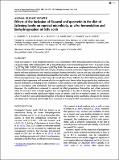Por favor, use este identificador para citar o enlazar a este item:
http://hdl.handle.net/10261/132112COMPARTIR / EXPORTAR:
 SHARE SHARE
 CORE
BASE CORE
BASE
|
|
| Visualizar otros formatos: MARC | Dublin Core | RDF | ORE | MODS | METS | DIDL | DATACITE | |

| Título: | Effects of the inclusion of flaxseed and quercetin in the diet of fattening lambs on ruminal microbiota, in vitro fermentation and biohydrogenation of fatty acids |
Autor: | Andrés, Sonia CSIC ORCID ; Bodas, Raúl CSIC ORCID; Tejido, María L. CSIC; Giráldez, Francisco Javier CSIC ORCID ; Valdés, Carmen CSIC ORCID ; López, Secundino CSIC ORCID | Palabras clave: | Conjugated linoleic acids Real-time PCR 16S rRNA Dairy-Cows Rumen biohydrogenation Condensed tannins Supplementation Sheep Digestion Profiles |
Fecha de publicación: | abr-2016 | Editor: | Cambridge University Press | Citación: | Journal of Agricultural Science 154 (3): 542-552 (2016) | Resumen: | Thirty-two lambs (n=8 per treatment) were fed a total mixed ration (TMR) formulated either with palm oil (CTRL; 34g palm oil/kg TMR) or flaxseed (FS) (85g FS/kg TMR) alone or enriched with quercetin (QCT, 34g palm oil plus 2g QCT/kg TMR; FS-QCT, 85g FS plus 2g QCT/kg TMR). The animals were slaughtered after being fed for at least 5 weeks with the experimental diets and samples of ruminal contents and ruminal liquid were collected for quantitative real-time polymerase chain reaction analyses of ruminal microbial species and fatty acid profile or in vitro fermentation, respectively. Results demonstrated that Butyrivibrio vaccenic acid (VA) and Butyrivibrio stearic acid (SA) producing bacteria copy numbers were decreased when FS was added to the diet of fattening lambs, which seemed to be in agreement with numerically (but not significantly) lower values for gas production, methane production and butyric acid during in vitro incubation. Ciliate protozoa were significantly enhanced by QCT, which was in accordance with numerically (but not significantly) higher values for in vitro methane production. Moreover, the modifications observed in ruminal microbial populations (Butyrivibrio and ciliate protozoa) when FS and QCT were included together (but not separately) in the diet of fattening lambs were probably related to a trend towards significantly higher values of rumenic acid (RA) in ruminal content. In conclusion, when FS and QCT were administered together in the diet of fattening lambs quantitative changes in the ruminal microbiota were observed, which might have promoted an increment of RA concentration in ruminal contents. | Descripción: | 11 páginas, 5 tablas, 2 figuras. | Versión del editor: | http://dx.doi.org/ 10.1017/S0021859615001094 | URI: | http://hdl.handle.net/10261/132112 | DOI: | 10.1017/S0021859615001094 | ISSN: | 0021-8596 | E-ISSN: | 1469-5146 |
| Aparece en las colecciones: | (IGM) Artículos |
Ficheros en este ítem:
| Fichero | Descripción | Tamaño | Formato | |
|---|---|---|---|---|
| Andrés, S._ Effects of the inclusion of flaxeed_Journal of Agricultural Science (2016).pdf | 173,5 kB | Adobe PDF |  Visualizar/Abrir |
CORE Recommender
SCOPUSTM
Citations
14
checked on 11-may-2024
WEB OF SCIENCETM
Citations
12
checked on 29-feb-2024
Page view(s)
314
checked on 17-may-2024
Download(s)
395
checked on 17-may-2024
Google ScholarTM
Check
Altmetric
Altmetric
NOTA: Los ítems de Digital.CSIC están protegidos por copyright, con todos los derechos reservados, a menos que se indique lo contrario.
